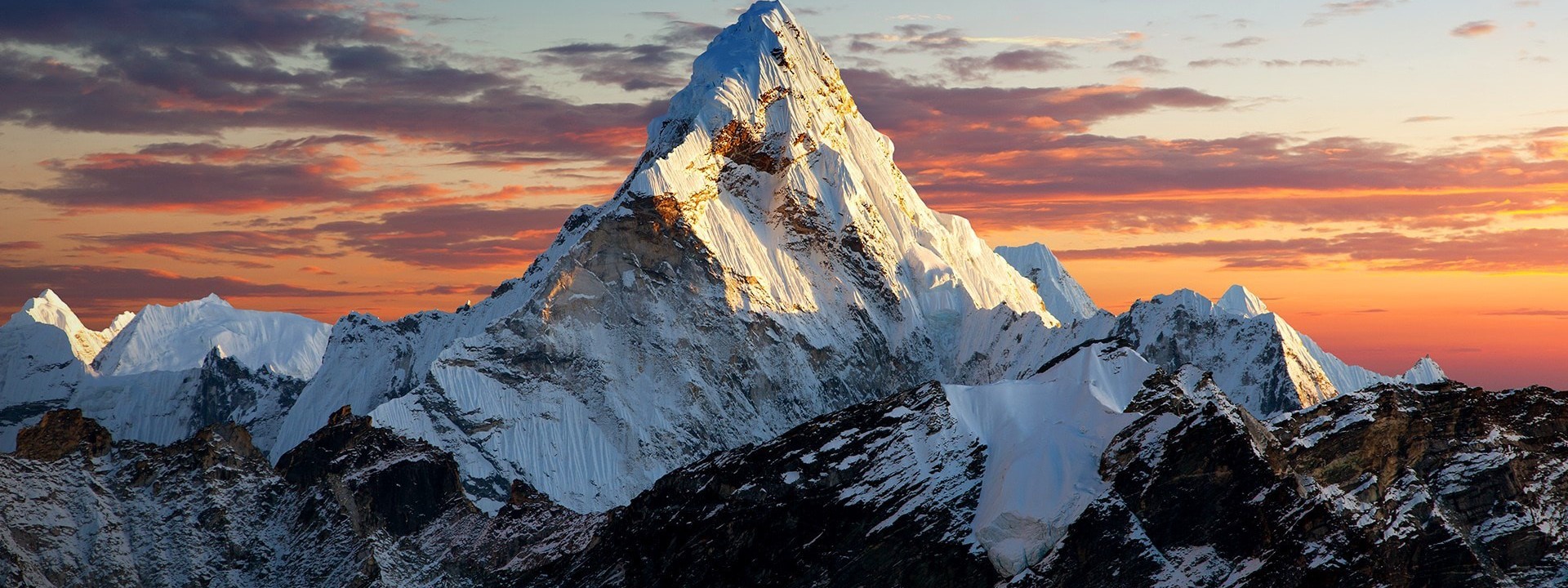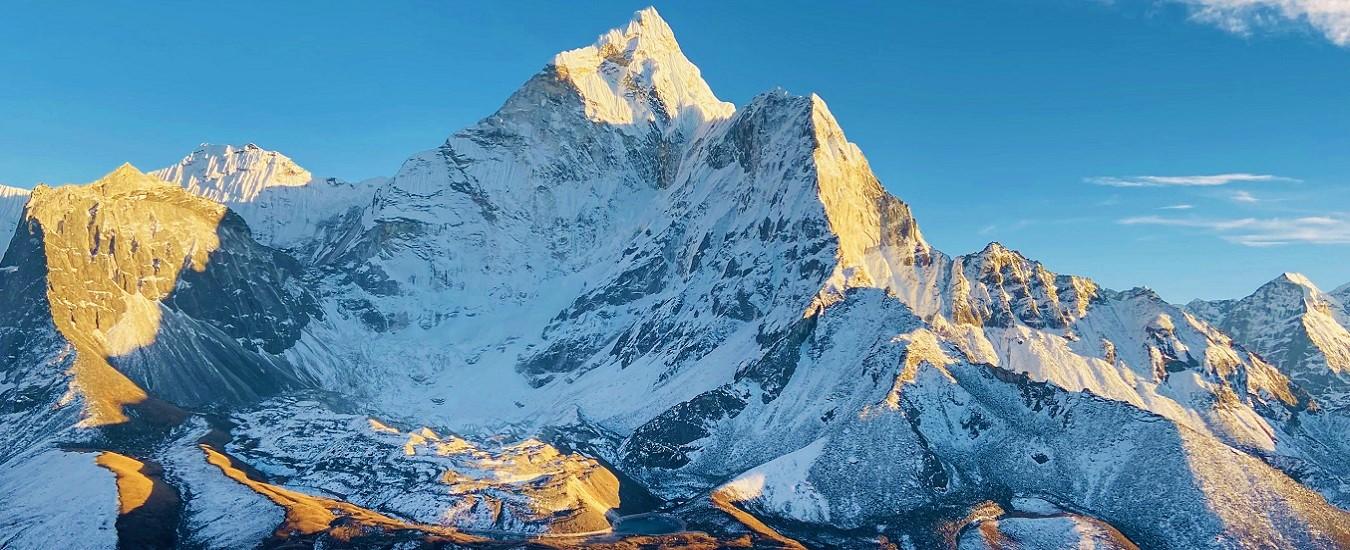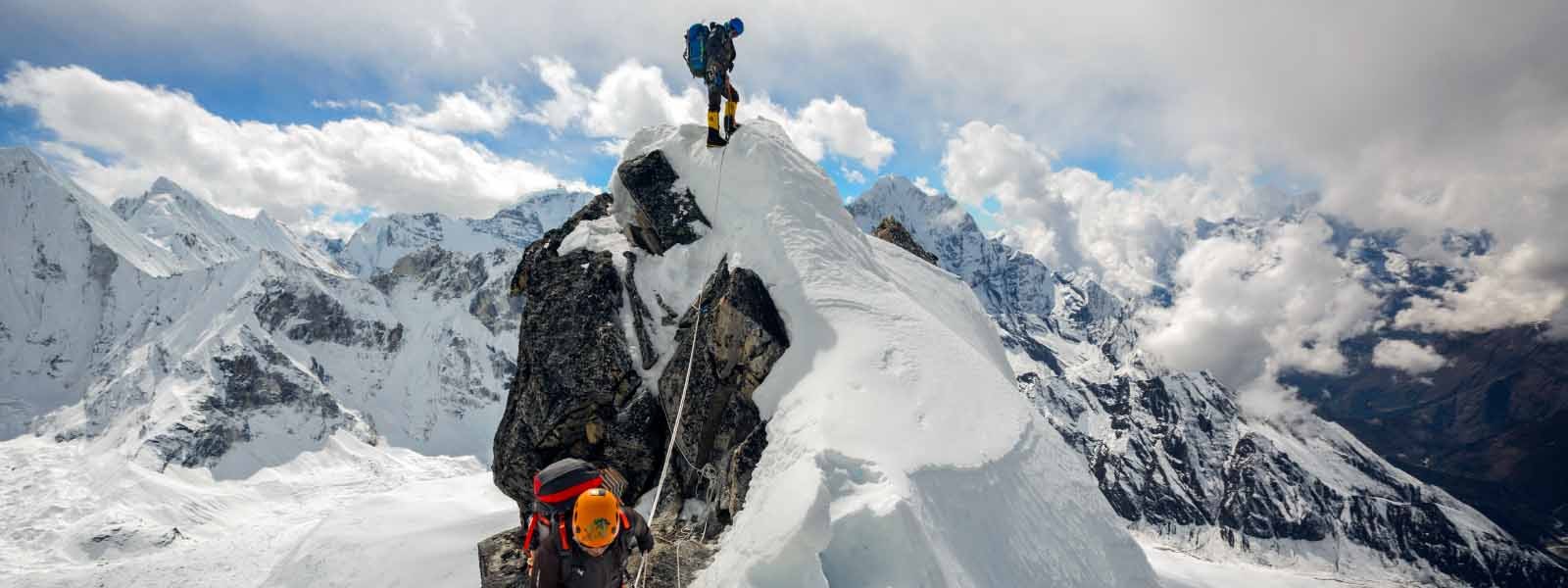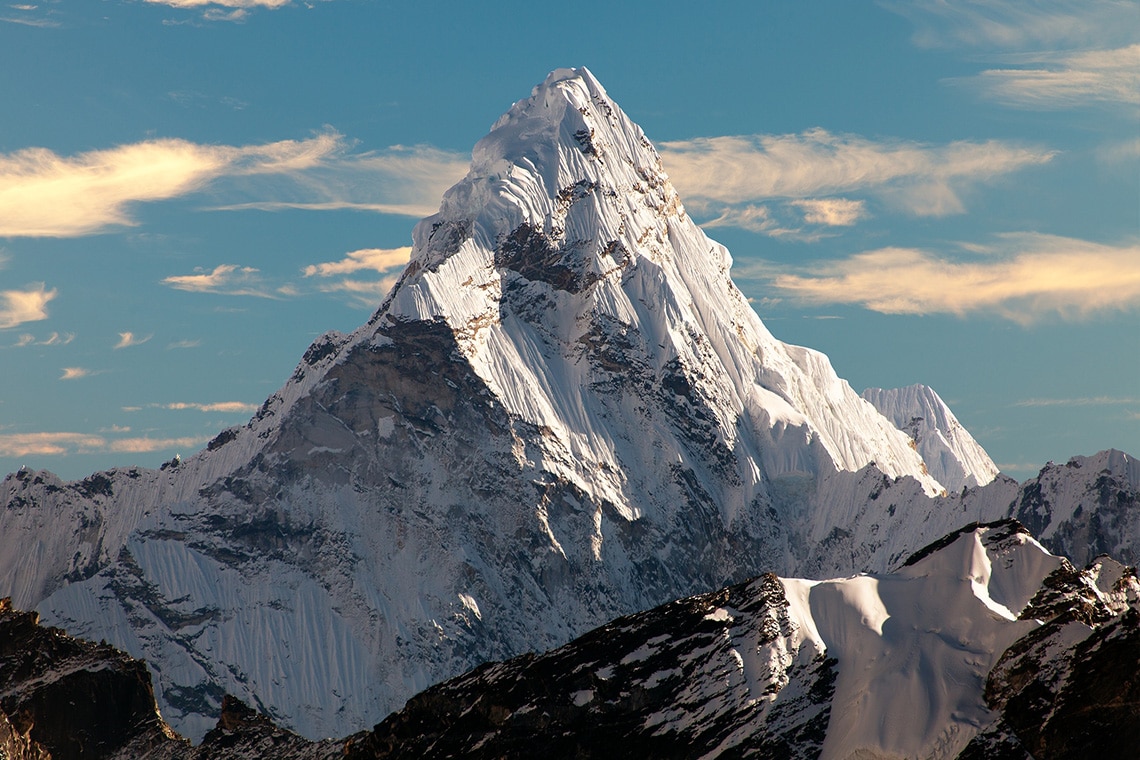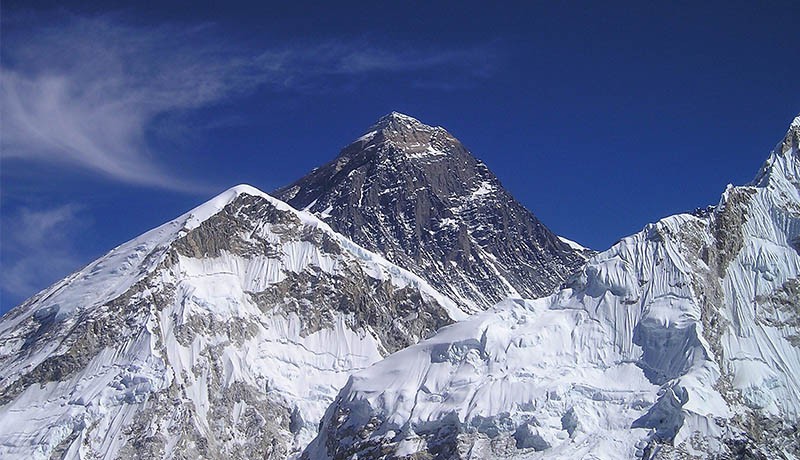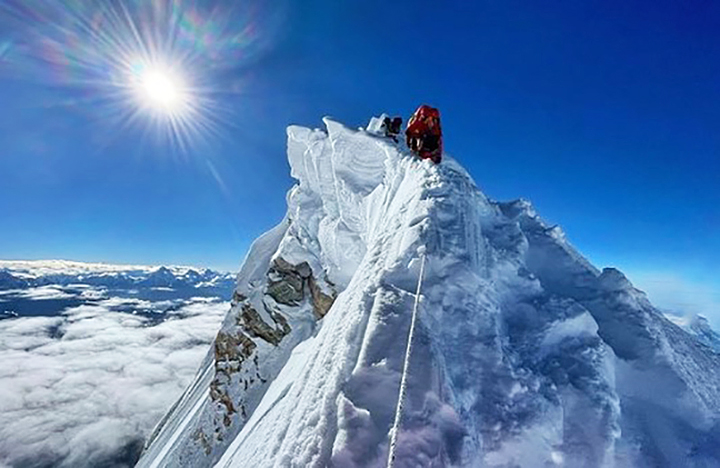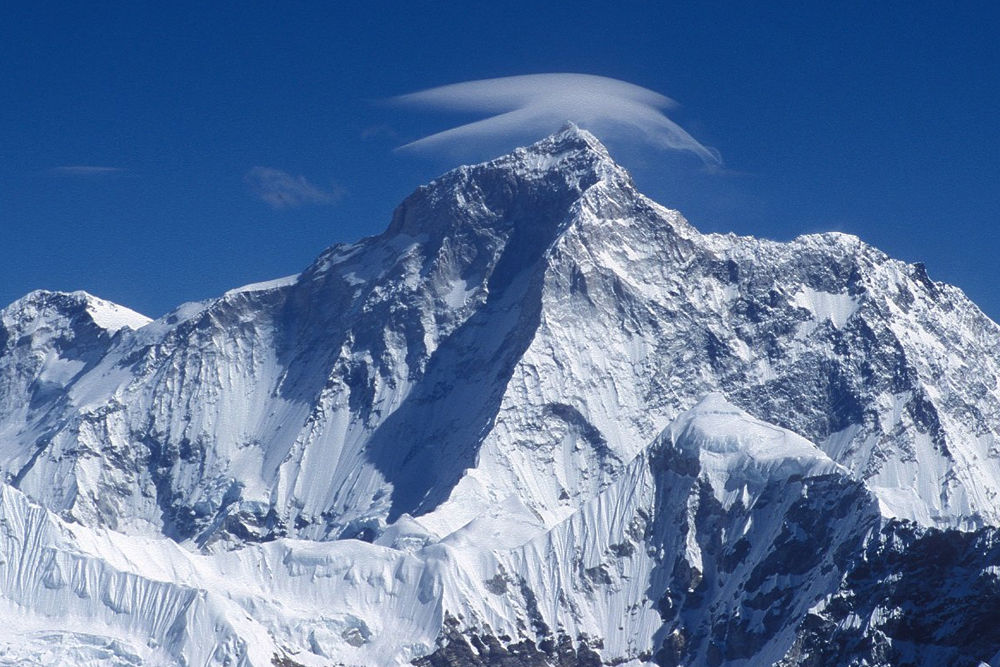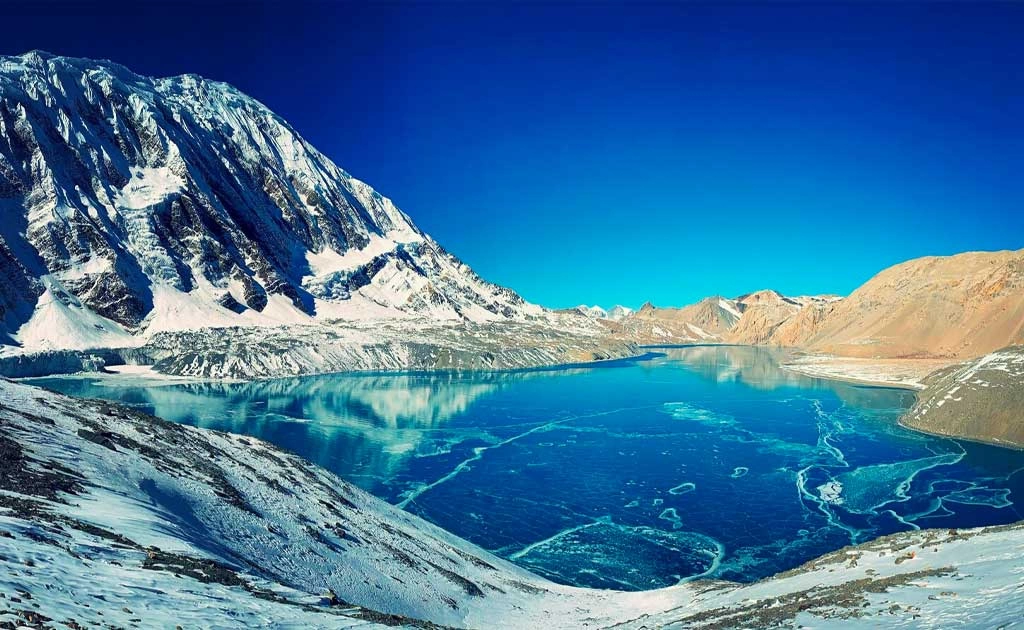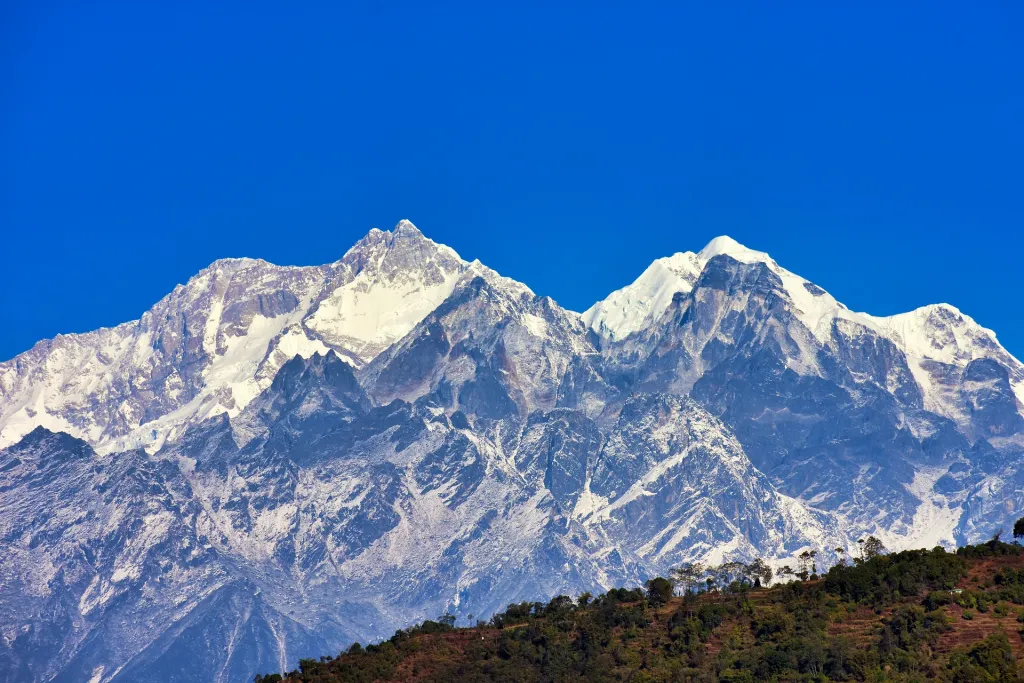Trip Facts
Highlights
- Iconic Himalayan Peak
- Stunning Scenery
- Challenging and Rewarding Climb
- Cultural Experience
- High-Altitude Adventure
- World-Class Base Camp
- Guided by Expert Teams
- Once-in-a-Lifetime Achievement
Overview
Mt. Ama Dablam is considered by some as the most beautiful mountain in the world. Whether you agree with such superlatives or not – it is certainly a remarkable peak that has a particular attraction to any keen mountaineer. Snowy Horizon has plenty of experience in organizing this expedition – a key to success (as well as safety) on the mountain.
The characteristic Pyramid shape led some to call Ama Dablam the ‘Matterhorn’ of the Himalayas and, at least as seen from Namche, there is a certain similarity. The hanging glacier on the southwest face of Ama Dablam resembles a ‘Dablam’- the sacred ornament box worn by Sherpa women –giving rise to the name “Ama Dablam” or “Mother’s necklace”.
Mt. Ama Dablam is located in the Khumbu region to the south of Everest and Lhotse. As you would expect, that allows for some stunning views during the climb as well as on the summit. The mountain stands above the famous Tangboche Monastery which is traditionally visited by climbers in the region.
It should be stressed that, despite all the pleasant parts, this is in general a demanding climb and participation in an Ama Dablam Expedition demands solid skills of rock climbing, ice climbing, sufficient experience of high altitude and general technical competency. There are steep ice sections to be overcome at high altitude and there are sections of serious exposure which can be particularly challenging. If you have previous climbing experience and wish to participate fully as a team member of an expertly led expedition to one of the world’s most impressive mountain then this Ama Dablam Expedition is the well-suited for you.
The most popular route for climbing Ama Dablam is the Southwest Ridge. The climb is typically done with three camps along the ridge.Camp 3 is usually established just below and to the right of the hanging glacier, the Dablam, so that any ice that calves off the glacier typically moves away from the camp. Nevertheless, a certain risk of serac falls cannot be avoided. As with other mountains in the region, the best climbing months are April-May before the monsoon season and September-October, after the monsoon.
Experience Required: All climbers need to have good skills on rock and ice climbing and technically competent. We will fix ropes and make use of the existing infrastructure (if any), however, the climbers should possess the necessary skills of climbing through steep rock and hard compact ice without them. We follow the standard South West ridge route (normal route) to the top, as it is consider the safer route with lower objective dangers such as avalanches.
We begin the approach as usual in the region from Lukla (2850m) and then slowly trek through the Sherpa villages along the trail. We take our time to properly acclimatize before we reach base camp and begin the climbing period. We at Snowy Horizon pride ourselves in executing this expedition with a focus on quality as well as safety.
As always, the package can be flexibly adjusted to your requirements (in case you want some additional acclimatization time beforehand etc.) – feel free to contact us any time for suggestions and advice. We’d be happy to take you on this adventure.
Ama Dablam Expedition Base Camp Service
- We provides very professional, supportive and friendly mountaineering logistic services from Kathmandu to the ABC as well as during the Expedition. Our objective is to ensure a good quality, supportive, safe, friendly, stress free and comprehensive service to maximize summit opportunity.
- We provide a comprehensive service organizing all necessary permits, and climbing documentation, travelling logistics including airfares, ground transportation, porters, and other individual services required by mountaineers. On the track to the ABC we organize all required accommodation and food.
- In the Base camp our cook and helpers will prepare and serve three times delicious freshly cooked and plentiful meals a day and will ensure that hot and cold drinks are available 24hrs a day.
- We provide spacious expedition quality personal tents for all our clients.
- We also provide dining tent, kitchen tent, toilet facilities and portable shower facilities and tent accommodation for our staff.
- We provide access to communication including satellite telephone and internet access, and solar panels to charge your batteries.
Ama Dablam Expedition Full Board Service
- In full board Service we provide personal tent and food, which will be prepared by their climbing Sherpa.
- We provide UHF/VHF handheld radios on the mountain to maintain communications between ABC and high camps.
- We provide a personal climbing Sherpa guide to help the clients to reach the summit. Personal climbing Sherpa will set up camp 1, camp 2 and camp 3 including food and fuel provisions, and assist the client all the way to the summit on this technical climb, where one requires a climbing buddy and a be layer. The climb requires cooperation between teams in setting up fixed ropes. Our camp manager and guides will coordinate work with other teams on the route setting.
Approaches to ABC
Approach to the Base camp is short, sweet and beautiful beginning with the amazing flight to Lukla and following Everest Base camp trail through Namche Bazaar to Pengboche and peeling off it just past Pangboche. The Base camp is located at 4200m.
Climbing Routes
The standard climbing route is via the Southwest ridge with typical arrangement of 3 high camps: Camp 1 (5600m), Camp 2 (5900m) and Camp 3 (6200m) with Base Camp at 4500m and High Camp at 5000m.
High Camp is located 150m below the ridge and all other 3 camps are directly on the ridge ensuring a great vantage point for all camps for stunning views.
Itinenary
Upon your arrival at the TIA, you will need to fulfill some official procedures to obtain the Nepal Entry Visa at the Immigration counter. One of Nomadways Adventure representatives will be waiting to welcome you at the Arrivals. After the meet and greet, you will be transferred to the hotel booked for you to rest. There you can freshen up and rest.
On the second day, we will fulfill all our official procedures including necessary documentation, obtain permits, and other formalities needed for our expedition. Then you will have time for sightseeing around the city.
The next day, we will start our preparation for our expedition. We will now pack our bags, do some necessary shopping, and re-check everything that we need (Especially medicines and essentials). Briefings will be made about every aspect of the expedition and all gear and equipment, trip duration, accommodation, facilities at the base camp, and all related to the expedition. It is also an opportunity for you to communicate and introduce yourself to your fellow climbers and teammates.
After an amazing breakfast, we will take a thrilling flight to Lukla Airport early in the morning. The flight gives you a bird’s eye view of the valleys, rivers, hills, and gradually mountain ranges. Even though the flight is only for half an hour, it does not fail to mesmerize you now and then. As we land at Lukla Airport, which is already exciting, we start our trek to Phakding, our destination for the day. After obtaining the permit for the region, we will slowly move through the settlements on a mixed trail of dirt, stone pathways, and some rocky sections at times. This is an easy start, so make sure to enjoy all the greeneries, floras, and faunas as you walk. The trail takes you over several suspension bridges and along the Dudh Koshi river. Enjoy the rest of the day at Phakding.
After Phakding, we move towards another beautiful destination, Namche Bazaar, which is the commercial point of the Khumbu region. Passing through the dense luscious forests of pine, juniper, Rhododendron, looking out for animals in the Sagarmatha National Park, climbing the stairs, enjoying the rages of rivers at some points, and mostly walking uphills are the major activities of the day’s trek. This trek will be long and tiring as we start gaining significant elevation. As we reach Namche, we rest at our hotel and enjoy our dinner.
The next day, we hike up to Everest View Point (3900m) & decend back to our hotel to acclimatize where we can also go around the village area and experience some local sherpa culture. We can also visit the Everest Photo Gallery and the Sherpa Museum while in Namche.
After a day’s rest and acclimatization at Namche, we then approach one of the most beautiful and tranquil parts of this Expedition, the Tengboche monastery. Tengboche monastery is one of the most popular monasteries among Buddhists around the world. The views of Mt. Everest, Nuptse, Lhotse, and Ama Dablam are visible towards the north while Thamserku and Kangtega stand towards the south with striking views. We will also join in some prayer ceremonies and rest for the day.
After Tengboche monastery, we head towards the base camp of Ama Dablam which is situated in a beautiful meadow also used as the Yak Pasture beneath the west face of the mountain. We cross the Imja River over a suspension bridge and hike up to Pangboche simultaneously leading the trail uphill through forests of junipers, the high-altitude tree lines. The route lies in the quieter region of the Khumbu valley. Embracing the 360 degrees view of the mountains like Kangtega (6783 m), Taboche (6542 m), Thamserku (6618 m), and many more, we reach Ama Dablam base camp at 4450 m.
After a long trek up to the Base Camp, we allocate two more days for rest and acclimatization before heading to the summit. During these days, we go on short excursions and prepare ourselves for the summit. We will also conduct some brief training related to the mountaineering gears and equipment and also practice walking with fixed ropes on small cliffs.
After the equipment check and preparation, we head towards camp 1 (5700 m) through easy terrain. But the trail gets technical with steep and difficult slopes before a steep ridge and requires tackling a steep slab.
Before heading for the summit push, we will be acclimatizing by completing the following rotation. We will be heading to Camp I from Base Camp and staying overnight at Camp I. The next day we will be heading to Camp II from Camp I & staying overnight at Camp II & return to base camp the next day. Camp 2 is set up at around 5900 m. We will need to climb past steep ridges and snowy slopes with the help of fixed ropes set up by our team.
The summit climb is an easy one. We wake up early, have our breakfast, and climb up on snowy slopes mixed with rocks above Camp 2.
We will ascend the peak of marvelous Ama Dablam (6812m) and return back to the Base Camp. The following day will be allocated for cleaning up and preparation to leave.
(NOTE: We will conduct rotations between the camps for acclimatization and training purposes. The mentioned itinerary is an overview of the circumstances during the climb.)
After the successful ascent of Ama Dablam, we retrace our path to Namche and rest overnight in a comfortable lodge.
From Namche, we walk downhill through the enchanting forests crossing the villages of Monjo and Phakding to reach Lukla to rest overnight.
From Lukla, we take the exciting flight back to Kathmandu viewing and bidding farewell to the Khumbu Region and the majestic Himalayas. After a flight of about 25 minutes, we land at the airport and get back to the hotel to rest and relax. You can go sightseeing around the city in the evening.
It’s a free day in Kathmandu for you to relax and explore around. You can take this opportunity to visit different World Heritage sites and buy some souvenirs for your family and friends.
With gratitude and lots of beautiful memories, we will have to bid you farewell to our valued clients. One of our representatives will drop you off at the airport 3 hours before your scheduled departure.
Cost Includes:
- All airport transfers
- Luxury Hotel in Kathmandu for two nights with breakfast
- All necessary paperwork and trekking permits (National Park permit and TIMS)
- An experienced English-speaking Govt. registered trekking guide and local porters to carry luggage (2 trekkers: 1 porter)
- Full meals: Breakfast, Lunch & Dinner of your choice
- Supplementary snacks: energy bar and cookies
- Seasonal fresh fruits desert every day
- Unlimited Chlorine treated Safe Drinking water
- Accommodation: Lodge
- A comprehensive First Aid kit
- Oxi-meter: To check heart rating and oxygen saturation to Everest Base Camp and return
- All government and local taxes
- Trekking equipment: down-filled sleeping bag, walking poles, and duffel bag
- Souvenir: Trekking Route map printed T-Shirts
Cost Excludes:
- Lunch and dinner in Kathmandu
- Hot and bottled drinks
- Electronic device re-charge Wi-Fi
- Hot shower
- Travel insurance and medical evacuation
- Tipping
Equipment
Trekking requires careful selection of gear to ensure comfort, safety, and efficiency on the trail. Depending on the conditions (terrain, weather, duration), the equipment you need may vary, but here’s a comprehensive list of essential trekking gear:
- Backpack
- Capacity: Typically, for a multi-day trek, a 40-60L pack is ideal.
- Fit: Adjustable straps for shoulder, chest, and hip.
- Features: Hydration system compatibility, side pockets for easy access, and a rain cover.
- Footwear
- Trekking Boots: Look for boots with good ankle support, durable soles (Vibram is a popular choice), and waterproof features.
- Trail Shoes: For lighter treks or well-maintained paths, trail shoes may suffice.
- Sock Layers: Merino wool socks or synthetic socks that wick moisture and reduce blisters. Avoid cotton.
- Gaiters: To keep debris, mud, and snow out of your boots.
- Clothing (Layering System)
- Base Layer: Moisture-wicking (synthetic or merino wool) long-sleeve top and bottoms.
- Mid Layer: Insulating layer, such as a fleece or down jacket.
- Outer Layer (Shell): Waterproof, windproof jacket and pants. Gore-Tex or similar fabrics are excellent choices.
- Trekking Pants: Convertible pants (with zippers for shorts) can be useful.
- Trekking Shirt: Lightweight, moisture-wicking, and quick-drying.
- Gloves: Lightweight gloves for warmth, plus an additional heavier pair if trekking in cold climates.
- Hat/Cap: A sunhat or beanie depending on the weather.
- Neck Gaiter/Buff: For sun protection, warmth, or dust.
- Sleeping Gear
- Sleeping Bag: Temperature-rated for the conditions you’ll face. Down bags are warmer and lighter but lose effectiveness if wet, while synthetic bags dry quicker.
- Sleeping Pad: Inflatable or foam pads that insulate from the cold ground.
- Tent: Lightweight trekking tents (1-3 person) that suit your conditions. Some options include 4-season tents if you're trekking in harsh weather.
- Hydration System
- Water Bottles: Collapsible or hard plastic bottles (ensure they’re BPA-free).
- Hydration Reservoir: Camelbak or similar bladder systems for easy access to water.
- Water Purification: A filtration system (e.g., Sawyer, LifeStraw) or chemical tablets to purify water from streams or other sources.
- Food and Cooking
- Stove: Compact gas or alcohol stove for cooking on the trail.
- Cookware: Lightweight pots or pans, often titanium or aluminum.
- Fuel: Compatible fuel for your stove (check for availability in the region you’re trekking).
- Food: Dehydrated meals, energy bars, trail mix, nuts, and fruits. Lightweight, high-calorie, and easy-to-prepare foods are best.
- Navigation Tools
- Map and Compass: Always have a paper map as a backup, even if you use a GPS.
- GPS Device or Smartphone with a Trekking App: Make sure to download offline maps.
- Altimeter Watch (optional): Useful for tracking elevation and route progress.
- Lighting
- Headlamp: Hands-free lighting for night-time use, with extra batteries.
- Flashlight: A backup to your headlamp.
- First Aid Kit
- Include basic supplies: Bandages, antiseptic wipes, blister treatment, pain relievers, and any personal medications.
- Personal Medications: Always bring enough for the whole trip, plus extras in case of delays.
- Sunscreen and Lip Balm: Protect your skin from sun exposure.
- Safety Gear
- Multi-tool/Knife: A good multi-tool (like a Swiss Army Knife or Leatherman) is very useful for repairs and emergencies.
- Whistle: For signaling.
- Emergency Blanket: Lightweight and compact for warmth in case of emergency.
- Firestarter: Matches or a lighter, and waterproof if needed.
- Miscellaneous
- Trekking Poles: Help with balance, reduce strain on knees, and improve traction on uneven terrain.
- Towel: Quick-dry, compact towel.
- Sunglasses: UV protection for your eyes.
- Camera/Smartphone: For documenting the journey, with extra storage or a portable charger.
- Personal Hygiene and Toiletries
- Toilet Paper: Always carry biodegradable toilet paper and a small trowel for digging a "cathole" if there are no facilities.
- Hand Sanitizer: To keep clean without access to water.
- Wet Wipes: For cleaning yourself when there's no shower.
- Biodegradable Soap: If you need to wash, use eco-friendly soap.
- Toothbrush/Toothpaste: Compact travel versions.
- Weather Protection
- Sun Protection: Sunglasses, sunblock, and a wide-brimmed hat for sun protection.
- Rain Gear: A high-quality waterproof jacket, pants, and gaiters, especially if you're trekking in areas with unpredictable weather.
- Cold Weather Gear (if needed): Depending on the trek, you might need additional gear like down jackets, insulated gloves, or even crampons for ice or snow.
- High-altitude Treks: Consider gear for altitude sickness (like Diamox), extra layers for extreme cold, and an oxygen system if necessary.
- Long-distance Treks: You might need additional gear like extra food storage, a larger stove, or a lightweight trekking umbrella.
FAQ's
It is situated near Mount Everest in the Khumbu Valley, Nepal, overlooking the trail to Everest Base Camp.
Ama Dablam is considered a technical climb requiring previous mountaineering experience. Climbers face steep ice, rock, and snow sections, making it a Level 5 (extremely difficult) climb.
Climbers should be in excellent physical condition with prior high-altitude experience. Training should include cardiovascular fitness, strength training, and technical climbing practice.
Training at high altitudes, using altitude chambers, or trekking to similar heights beforehand can help. Adequate acclimatization during the expedition is crucial.
